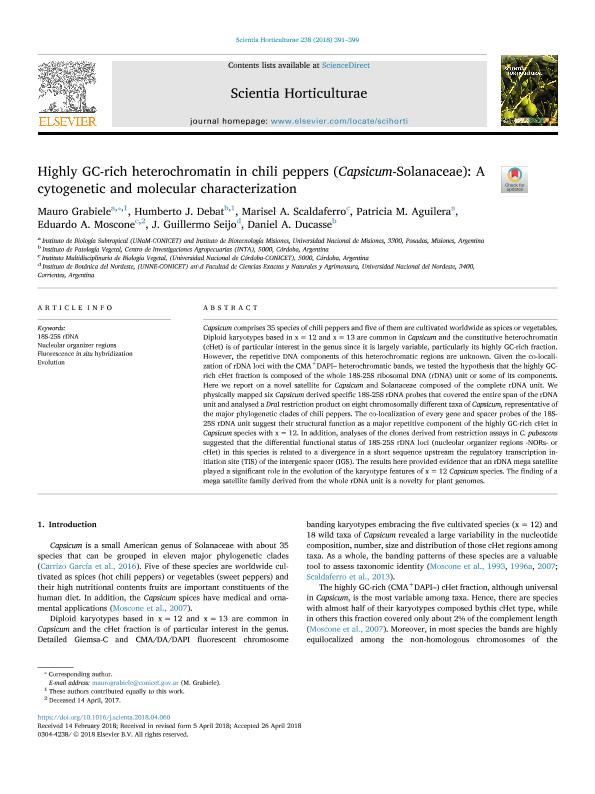Mostrar el registro sencillo del ítem
dc.contributor.author
Grabiele, Mauro

dc.contributor.author
Debat, Humberto Julio

dc.contributor.author
Scaldaferro, Marisel Analía

dc.contributor.author
Aguilera, Patricia Mabel

dc.contributor.author
Moscone, Eduardo Alberto

dc.contributor.author
Seijo, José Guillermo

dc.contributor.author
Ducasse, Daniel Adrián

dc.date.available
2019-09-02T18:13:29Z
dc.date.issued
2018-08
dc.identifier.citation
Grabiele, Mauro; Debat, Humberto Julio; Scaldaferro, Marisel Analía; Aguilera, Patricia Mabel; Moscone, Eduardo Alberto; et al.; Highly GC-rich heterochromatin in chili peppers (Capsicum-Solanaceae): A cytogenetic and molecular characterization; Elsevier Science; Scientia Horticulturae; 238; 8-2018; 391-399
dc.identifier.issn
0304-4238
dc.identifier.uri
http://hdl.handle.net/11336/82729
dc.description.abstract
Capsicum comprises 35 species of chili peppers and five of them are cultivated worldwide as spices or vegetables. Diploid karyotypes based in x = 12 and x = 13 are common in Capsicum and the constitutive heterochromatin (cHet) is of particular interest in the genus since it is largely variable, particularly its highly GC-rich fraction. However, the repetitive DNA components of this heterochromatic regions are unknown. Given the co-localization of rDNA loci with the CMA+DAPI– heterochromatic bands, we tested the hypothesis that the highly GC-rich cHet fraction is composed of the whole 18S-25S ribosomal DNA (rDNA) unit or some of its components. Here we report on a novel satellite for Capsicum and Solanaceae composed of the complete rDNA unit. We physically mapped six Capsicum derived specific 18S-25S rDNA probes that covered the entire span of the rDNA unit and analysed a DraI restriction product on eight chromosomally different taxa of Capsicum, representative of the major phylogenetic clades of chili peppers. The co-localization of every gene and spacer probes of the 18S-25S rDNA unit suggest their structural function as a major repetitive component of the highly GC-rich cHet in Capsicum species with x = 12. In addition, analyses of the clones derived from restriction assays in C. pubescens suggested that the differential functional status of 18S-25S rDNA loci (nucleolar organizer regions -NORs- or cHet) in this species is related to a divergence in a short sequence upstream the regulatory transcription initiation site (TIS) of the intergenic spacer (IGS). The results here provided evidence that an rDNA mega satellite played a significant role in the evolution of the karyotype features of x = 12 Capsicum species. The finding of a mega satellite family derived from the whole rDNA unit is a novelty for plant genomes.
dc.format
application/pdf
dc.language.iso
eng
dc.publisher
Elsevier Science

dc.rights
info:eu-repo/semantics/openAccess
dc.rights.uri
https://creativecommons.org/licenses/by-nc-sa/2.5/ar/
dc.subject
18s-25s Rdna
dc.subject
Evolution
dc.subject
Fluorescence in Situ Hybridization
dc.subject
Nucleolar Organizer Regions
dc.subject.classification
Ciencias de las Plantas, Botánica

dc.subject.classification
Ciencias Biológicas

dc.subject.classification
CIENCIAS NATURALES Y EXACTAS

dc.title
Highly GC-rich heterochromatin in chili peppers (Capsicum-Solanaceae): A cytogenetic and molecular characterization
dc.type
info:eu-repo/semantics/article
dc.type
info:ar-repo/semantics/artículo
dc.type
info:eu-repo/semantics/publishedVersion
dc.date.updated
2019-08-01T21:50:30Z
dc.journal.volume
238
dc.journal.pagination
391-399
dc.journal.pais
Países Bajos

dc.journal.ciudad
Amsterdam
dc.description.fil
Fil: Grabiele, Mauro. Consejo Nacional de Investigaciones Científicas y Técnicas. Centro Científico Tecnológico Conicet - Nordeste. Instituto de Biología Subtropical. Universidad Nacional de Misiones. Instituto de Biología Subtropical; Argentina
dc.description.fil
Fil: Debat, Humberto Julio. Instituto Nacional de Tecnología Agropecuaria. Centro de Investigaciones Agropecuarias. Instituto de Patología Vegetal; Argentina. Consejo Nacional de Investigaciones Científicas y Técnicas; Argentina
dc.description.fil
Fil: Scaldaferro, Marisel Analía. Consejo Nacional de Investigaciones Científicas y Técnicas. Centro Científico Tecnológico Conicet - Córdoba. Instituto Multidisciplinario de Biología Vegetal. Universidad Nacional de Córdoba. Facultad de Ciencias Exactas Físicas y Naturales. Instituto Multidisciplinario de Biología Vegetal; Argentina
dc.description.fil
Fil: Aguilera, Patricia Mabel. Consejo Nacional de Investigaciones Científicas y Técnicas. Centro Científico Tecnológico Conicet - Nordeste. Instituto de Biología Subtropical. Universidad Nacional de Misiones. Instituto de Biología Subtropical; Argentina
dc.description.fil
Fil: Moscone, Eduardo Alberto. Consejo Nacional de Investigaciones Científicas y Técnicas. Centro Científico Tecnológico Conicet - Córdoba. Instituto Multidisciplinario de Biología Vegetal. Universidad Nacional de Córdoba. Facultad de Ciencias Exactas Físicas y Naturales. Instituto Multidisciplinario de Biología Vegetal; Argentina
dc.description.fil
Fil: Seijo, José Guillermo. Consejo Nacional de Investigaciones Científicas y Técnicas. Centro Científico Tecnológico Conicet - Nordeste. Instituto de Botánica del Nordeste. Universidad Nacional del Nordeste. Facultad de Ciencias Agrarias. Instituto de Botánica del Nordeste; Argentina
dc.description.fil
Fil: Ducasse, Daniel Adrián. Instituto Nacional de Tecnología Agropecuaria. Centro de Investigaciones Agropecuarias. Instituto de Patología Vegetal; Argentina
dc.journal.title
Scientia Horticulturae

dc.relation.alternativeid
info:eu-repo/semantics/altIdentifier/doi/http://dx.doi.org/10.1016/j.scienta.2018.04.060
dc.relation.alternativeid
info:eu-repo/semantics/altIdentifier/url/https://www.sciencedirect.com/science/article/pii/S0304423818303157
Archivos asociados
